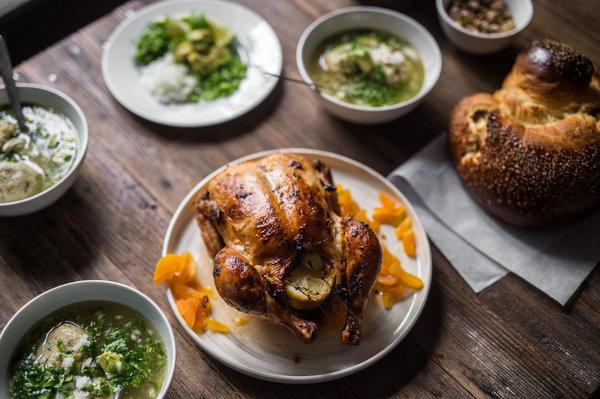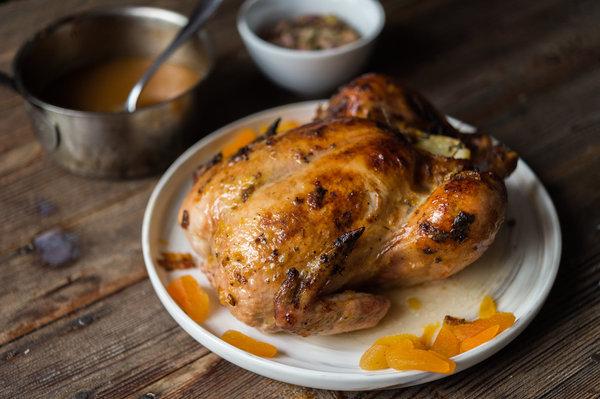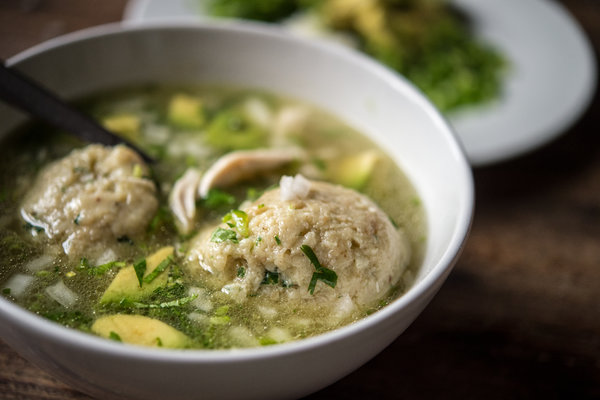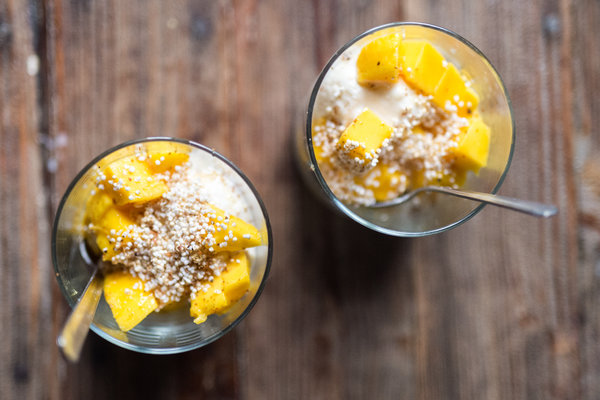The chef Fany Gerson’s holiday feast is born of her Jewish heritage and Mexico City upbringing.

While on the surface Mexican and Jewish cooking couldn’t be more distant, they are both “very tradition-rooted, very proud, very family-oriented,” said Fany Gerson, who grew up in Mexico. “Both Mexican and Jewish cultures are very soulful.”CreditCreditPhotograph by Daniel Krieger for the New York Times
By Priya Krishna
In the late 1920s, the chef Fany Gerson’s grandparents, Jewish and facing persecution, fled Ukraine and boarded boats bound for New York City. But they weren’t able to immigrate through Ellis Island, for reasons they can’t quite remember — perhaps because of financial turmoil preceding the 1929 stock market crash, or because of limits set a few years earlier on the number of immigrants from certain countries.
So they settled in the closest country that would take them: Mexico.
To feel at home, they cooked. They made matzo ball soup, challah, gefilte fish — dishes that were typical of Ashkenazi Jewish cuisine, born of scarcity and cold climates and seemingly far different from Mexican cooking, with its abundant produce and aromatic spices.
But over the years, the family’s colorful surroundings crept into those monochromatic Jewish dishes. The challah became laced with flowery Mexican cinnamon and tart apples, the matzo balls filled with herbs and onions, and the gefilte fish dressed in a guajillo pepper sauce. This is the food Ms. Gerson grew up eating in Mexico City.
Now Ms. Gerson, 42, lives in New York. She runs a Mexican sweet shop, La Newyorkina, is co-owner of a doughnut business, Dough, and celebrates her family’s culinary traditions by cooking a vast Mexican-Jewish meal for her friends on Rosh Hashana, the Jewish new year. (The holiday, which marks the start of the Jewish High Holy Days, begins this year on Sunday evening and ends Tuesday at sundown.)
While on the surface Mexican and Jewish cooking couldn’t be more distant, they are both “very tradition-rooted, very proud, very family-oriented,” she said. “Both Mexican and Jewish cultures are very soulful.”
Mexico has one of the largest Jewish populations in Latin America, numbering 40,000 as of two years ago, according to the “American Jewish Year Book 2016.” Yet Ms. Gerson attended an international school, rather than a Jewish school, partially out of her father’s fear that the family would be ostracized because Ms. Gerson’s mother was a convert.
Where Ms. Gerson felt most connected to her faith was her grandmother’s house. This was the setting for the family’s Jewish holiday meals, which almost always included that spicy matzo ball soup, apple-cinnamon challah and guajillo-pepper gefilte fish, as well as a sticky honey cake, cherry-filled rugelach and a glistening roast chicken scattered with dried apricots. (Traditional dishes for the holiday may involve apples and honey, to symbolize a sweet new year; round challah, to suggest the circle of life; pomegranates, to signify abundance; and fish heads, used in the stock for gefilte fish, for fresh starts at the “head” of the year.)

Ms. Gerson’s roast chicken has an apricot glaze.CreditDaniel Krieger for The New York Times
Upon moving to New York in 1999, Ms. Gerson realized she didn’t have a place to go for the Jewish holidays. Rosh Hashana was approaching, so she decided to host the dinner herself.
There were too many versions of her grandmother’s ever-changing recipes, so Ms. Gerson turned to the cookbooks of the Jewish food expert (and New York Times contributor) Joan Nathan, then layered on Mexican ingredients. She was excited to discover that Ms. Nathan’s basic recipes weren’t all that different from her grandmother’s — their flavors just had “a little more subtlety,” she said with a laugh.
For that first dinner, Ms. Gerson’s 12 guests sat on the floor of her tiny place and ate off plastic plates. Still, she loved it.
“It was really exciting,” she said. “It was like my grandmother was with me.”
Two apartments and almost 20 years later, Ms. Gerson joked that the guest count has doubled but the apartment size hasn’t, so her guests — a diverse mix of friends and family, including many Mexican-Jewish friends she met in New York — still sit on the floor.
“I only know how to cook for big crowds,” Ms. Gerson said. “You would think I wouldn’t given the size of my apartment.”CreditDaniel Krieger for The New York Times
Her Upper West Side home is filled with stacks of books and records; the walls are crowded with colorful posters and paintings; and each surface is brimming with plates, bowls and anything else that won’t fit into her minuscule kitchen.
“I only know how to cook for big crowds,” she said. “You would think I wouldn’t given the size of my apartment.”
This year, the celebration will take place on Sunday, first night of Rosh Hashana. On the second night, she will prepare a Rosh Hashana dinner for patrons of the Mexico City-inspired restaurant Casa Pública in Williamsburg, Brooklyn, where her husband, Daniel Ortiz de Montellano, is an owner. Ms. Gerson will have at least one new addition to the festivities this year: her 3-month-old son, Gael Bernardo.
The day before her dinner at home, she kneads the dough for the challah, shaping it into a braided circle filled with apples cooked in sugar and Mexican cinnamon. The finished bread resembles a sleeping cat (not unlike her actual cat, Leonard, who is usually found dozing on the couch).
Ms. Gerson’s brightened-up matzo ball soup — inspired by her Jewish upbringing in Mexico City — has cilantro, onion, avocado and lime. CreditDaniel Krieger for The New York Times
Then she makes the chicken broth for the matzo ball soup, with cilantro, garlic and white onions — always white, never yellow, Ms. Gerson said, because the white ones are less sweet and “taste like Mexico.” She adds an extra chicken to the pot that she can use the next day to make tacos or enchiladas.
Ms. Gerson’s recipes aren’t entirely faithful to her grandmother’s. Her matzo balls are not the hard, golf-ball-size ones she ate growing up, but bigger and fluffier, a cross between her grandmother’s version and those at New York delis. (The first time she tried the deli version, she was taken aback by the unfamiliar texture: “I was like, ‘Well, clearly they don’t know how to make matzo balls.’”)
The chicken is glazed with a mixture of apricot jam, butter, garlic and oil, and served with a vibrant pan sauce made with more apricot butter, red wine vinegar, shallots and pan drippings.
The honey cake has become chile-infused honey ice cream topped with mango, ground pequín pepper and puffed amaranth — a nod to Ms. Gerson’s penchant for frozen treats. The ice cream is churned in a machine that sits on her living room floor.
The rugelach has chipotle peppers along with the cherries, for smokiness and a rustic touch; Ms. Gerson said her grandmother, who still lives in Mexico City, disapproved of this addition, arguing that the pastry was perfect the way it was. (This year, La Newyorkina will sell the honey ice cream and various types of rugelach through the High Holy Days, and the apple-cinnamon challah will be available for pre-order throughout the High Holy Days.)
For her friend Daniel Hirschhorn, it is a radical departure from the Jewish food he grew up eating in Mexico City. His parents, who were very traditional, didn’t care for chiles and spices. But Mr. Hirschhorn adores Ms. Gerson’s cooking.
“She totally was able to synthesize our old-school traditions with these flavors,” he said. “She is the Mexican balaboosta” — a Yiddish term for a perfect hostess.
Recipes: Matzo Ball Soup a la Mexicana | Roast Chicken With Apricot Glaze | Honey Ice Cream With a Kick
Cooking
Matzo Ball Soup a la Mexicana

Cooking
Roast Chicken With Apricot Glaze

Cooking
Honey Ice Cream With a Kick

Advertisement




